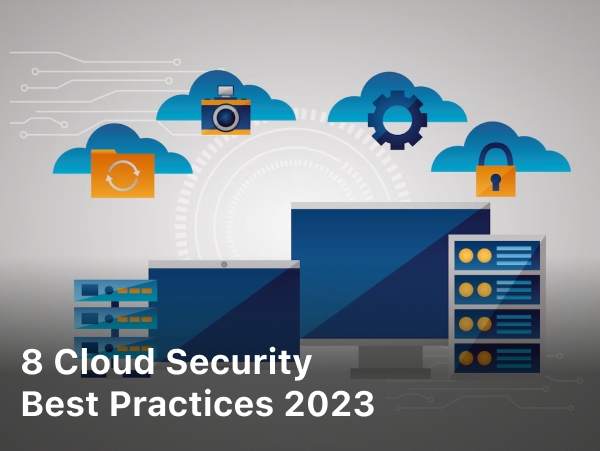8 Cloud Security Best Practices 2023
8 Cloud Security Best Practices 2023. Discover top 8 Cloud Security Best Practices for 2023 to safeguard your data and infrastructure in the ever-evolving cyber threat landscape. Stay protected now!
As more companies move their operations to the cloud, ensuring the security of their data and infrastructure becomes imperative. In 2023, the cyber threat landscape is expected to become even more complex, making it vital for organizations to implement robust cloud security measures.
8 Cloud Security Best Practices 2023
In this section, we will explore eight essential best practices for cloud security in 2023. These practices are crucial to safeguarding your data and infrastructure in the ever-evolving cyber threat landscape.
Key Takeaways:
- Cloud security best practices are essential in 2023.
- Implementing robust security measures is crucial to safeguarding your data and infrastructure in the ever-evolving cyber threat landscape.
- This article outlines eight essential best practices for cloud security in 2023.
What is Cloud Security?
Cloud security refers to the set of practices, technologies, policies, and procedures designed to protect data, applications, and infrastructure within a cloud computing environment. Cloud security aims to safeguard sensitive information, ensure data privacy, and defend against potential cyber threats and attacks.
In a cloud environment, data and applications are stored and processed on remote servers owned and maintained by a cloud service provider. This brings numerous advantages, such as scalability, flexibility, and cost-efficiency. However, it also introduces unique security challenges, as organizations need to entrust their data to third-party providers.
Understand Your Data and Infrastructure
When it comes to cloud security, understanding your data and infrastructure is crucial. You need to know what data you are storing in the cloud and where it is being stored. It is also important to understand how your cloud infrastructure is set up and who has access to it.
One of the best practices for cloud data security is to classify your data based on its sensitivity level. This will help you determine the appropriate security controls needed to protect it.
| Level | Example of Data Type | Security Controls Needed |
|---|---|---|
| Public | Brochures, Public Websites | No Security Controls Needed |
| Internal | Employee Data, Budgets | Access Controls, Encryption |
| Confidential | Customer Data, Financial Information | Multi-Factor Authentication, Encryption, Monitoring |
Another best practice for cloud security is to implement a data retention policy. This will ensure that you are not storing data longer than necessary and that you have a process in place for securely deleting data when it is no longer needed.

Best Practices for Cloud Infrastructure Security
In addition to securing your data, you must also secure your cloud infrastructure. One best practice for this is to implement the principle of least privilege. This means that users should only have access to the resources they need to do their job and no more.
It is also important to regularly conduct vulnerability scans and penetration testing to identify and address potential security weaknesses. Additionally, you should use network segmentation to isolate critical assets from the rest of your infrastructure.
Remember that cloud security is a shared responsibility between you and your cloud service provider. You are responsible for securing the data and applications you store in the cloud, while your provider is responsible for securing the underlying infrastructure.
By following these best practices for cloud data and infrastructure security, you can help minimize the risk of a security breach and protect your organization’s sensitive information.
Implement Strong Access Controls
Effective access controls are crucial for preventing unauthorized access to your cloud applications. In this section, we will explore the best practices for implementing strong access controls in your cloud environment.
1. Restrict Access Based on Least Privilege
Grant access only to those who require it for their job responsibilities and tasks. Users should be granted the least amount of privileges necessary to perform their tasks. This minimizes the exposure of your applications and data to unnecessary risk.
2. Utilize Role-Based Access Controls
Implement role-based access control (RBAC) to simplify access control management. Assign roles based on job duties, and grant permission to access resources based on pre-defined roles. This allows administrators to manage access control at scale and ensures that users only have access to the resources they need to perform their duties.
3. Implement Password Policies
Password policies should be enforced for all cloud users. Passwords should be complex, difficult to guess, and different for each user. Enforce regular password changes and use multi-factor authentication to further enhance password security.
4. Monitor User Activity
Monitor user activity for anomalous behavior. This helps detect potential security breaches and unauthorized access to your cloud environment. Use activity logs and security information and event management (SIEM) tools to monitor and analyze user activity.
5. Regularly Review Access Permissions
Regularly review and revoke access permissions for users who no longer require it or who have changed roles within the organization. This helps minimize the risk of data breaches caused by access permissions that were not updated.
Utilize Encryption
In today’s constantly evolving cyber threat landscape, encryption is one of the most essential cloud security best practices. It can help protect your sensitive data from unauthorized access and provide an additional layer of protection for your cloud infrastructure.
When implementing encryption in your cloud environment, it’s important to consider the following best practices:
| Best Practice | Description |
|---|---|
| Use Strong Encryption Algorithms | Choose encryption algorithms that are widely accepted and proven to be secure. Examples include Advanced Encryption Standard (AES) and Rivest-Shamir-Adleman (RSA). |
| Implement Key Management | Properly manage your encryption keys to ensure the confidentiality and integrity of your data. Use a strong key management system to securely generate, store, and distribute your keys. |
| Encrypt Data at Rest and in Transit | Encrypt your data both when it is at rest in storage and when it is in transit between different environments. This will keep your data protected at all times. |
| Regularly Rotate Encryption Keys | Periodically rotate your encryption keys to prevent them from being compromised. This can help you maintain the integrity of your data and protect it from attacks. |
Implementing these encryption best practices can help you enhance the security of your cloud infrastructure and protect your sensitive data from cyber threats.
Regularly Update and Patch
Regularly updating and patching your cloud infrastructure is essential for maintaining strong security in the ever-evolving cyber threat landscape. Outdated software and systems can leave your environment vulnerable to attacks.
To ensure your cloud environment remains up to date, establish a regular patching schedule. This schedule should include all components of your cloud infrastructure, including applications, operating systems, and virtual machines.
When implementing patches, it is essential to test them before deployment to avoid potential issues. Additionally, prioritize critical patches that address known vulnerabilities or exploits in your environment.
Establish clear procedures for patching and updating, including who is responsible for each task, how frequently patches are deployed, and how updates are tested and validated. These procedures should be reviewed regularly to ensure they remain relevant and effective.
Implement Multi-Factor Authentication
Multi-factor authentication (MFA) adds an extra layer of security to your cloud environment by requiring multiple forms of authentication to access sensitive data. The best practice is to implement MFA for all user accounts accessing your cloud infrastructure.
There are several types of authentication factors you can implement to strengthen your cloud security, such as:
| Factor Type | Description |
|---|---|
| Something you know | For example, a password or PIN number |
| Something you have | For example, a physical token or smartphone app |
| Something you are | For example, biometric data like fingerprints or facial recognition |
When implementing MFA, it is essential to choose factors that are strong and unique for each user. Encourage your users to avoid using the same factors for multiple platforms and regularly rotate their passwords and tokens. Continuous monitoring of MFA usage can also help you detect and respond to potential security incidents quickly.
Tip: Consider using a single sign-on (SSO) solution in conjunction with MFA. SSO allows users to access multiple applications with a single set of login credentials, streamlining access and reducing the risk of password fatigue. When combined with MFA, SSO provides a robust security solution for your cloud environment.
Monitor and Analyze Security Logs
Monitoring and analyzing security logs is crucial for maintaining the security of your cloud environment. By analyzing logs regularly, you can identify potential security incidents and take prompt action to address them before they cause damage.
Below are some best practices for effective monitoring and analysis of security logs in your cloud infrastructure:
- Define clear goals: Clearly define your logging goals and ensure that all logs are collected and analyzed in accordance with those goals.
- Consolidate logs: Consolidate logs from all sources into a centralized repository for easier analysis and correlation.
- Automate analysis: Make use of automated tools to analyze logs in real-time, freeing up your security team to focus on other areas of concern.
- Employ correlation rules: Use correlation rules to identify potential threats by analyzing logs from multiple sources and detecting patterns of unusual activity.
- Regularly review logs: Conduct regular reviews of your logs to identify trends and ensure that all activity is in line with your security policies and procedures.
- Maintain audit trails: Keep a detailed audit trail of all log activity to enable efficient investigation of potential security incidents.
By following these best practices, you can better protect your cloud environment against potential security threats and ensure the safety of your data and infrastructure.
Regularly Train and Educate Your Users
User education is a critical element of cloud security. With the increasing sophistication of cyber attacks, it is essential to ensure that your users are aware of best practices for cloud security. Regular training and education can help reduce the risk of human error, which is a leading cause of security breaches.
Here are some best practices to keep in mind when training and educating your users:
| Best Practice | Description |
|---|---|
| Use Real-World Examples | When educating your users, use real-world examples to illustrate the consequences of security breaches. This will help your users understand the importance of following best practices and how their actions can impact the security of your cloud environment. |
| Make It Interactive | Instead of lecturing your users, make your training sessions interactive. Use quizzes and games to keep your users engaged and reinforce their understanding of key concepts. |
| Personalize the Training | Different users may have different levels of experience and understanding when it comes to cloud security. Personalizing your training sessions to meet the needs of different users can help ensure that everyone has the knowledge and skills they need to keep your cloud environment secure. |
| Schedule Regular Training Sessions | Cyber threats are constantly evolving, and new best practices are emerging all the time. Schedule regular training sessions to keep your users up-to-date with the latest best practices and help them stay informed about the latest threats. |
By following these best practices, you can help ensure that your users are aware of their role in cloud security and have the knowledge and tools they need to keep your environment secure.
Keep Reading :
- What Are The Benefits Of Cloud Computing For Your Business
- What Is Internet Of Things Iot And How Is Connectivity
- How To Cloud Computing Works As Online Storage
- Cybersecurity vs Cloud Computing
Conclusion
Implementing the best practices for cloud security will ensure that your data and infrastructure remain secure in the ever-evolving cyber threat landscape of 2023 and beyond. By understanding your data and infrastructure, implementing strong access controls, utilizing encryption, regularly updating and patching, implementing multi-factor authentication, monitoring and analyzing security logs, and regularly training and educating your users, you can stay proactive and stay protected.
Remember to stay vigilant and keep up-to-date with the latest trends and developments in cloud security. By making cloud security a top priority, you can protect your business and your customers’ sensitive information, ultimately building trust and loyalty.
FAQ
Q: What are the essential cloud security best practices for 2023?
A: The essential cloud security best practices for 2023 include strong encryption protocols, multi-factor authentication, regular security audits, access controls, data backup and disaster recovery planning, secure APIs, continuous monitoring, and employee training.
Q: How does encryption protect cloud data?
A: Encryption ensures that your cloud data remains unreadable to unauthorized individuals. Even if an attacker gains access to your data, they won’t be able to understand it without the encryption keys.
Q: What is the principle of least privilege in cloud security?
A: The principle of least privilege dictates that users should only be granted the minimum level of access necessary to perform their tasks. This minimizes the risk of unauthorized access and potential data breaches.
Q: How can I ensure my cloud environment remains secure from emerging threats?
A: Regularly monitor your cloud environment, conduct security audits, and stay up-to-date with the latest security trends. Implementing robust security measures and educating employees about potential threats will help you stay ahead of emerging risks.
Q: Why is Multi-Factor Authentication crucial for cloud security?
A: Multi-Factor Authentication adds an extra layer of security by requiring users to provide multiple forms of identification. This significantly reduces the likelihood of unauthorized access, even if the user’s password is compromised.
Q: What is the role of continuous monitoring in cloud security?
A: Continuous monitoring actively detects security threats and anomalies in real-time. This allows for prompt response and mitigation of potential risks, safeguarding your cloud environment from various attacks.
Q: What is the conclusion for cloud security best practices in 2023?
A: Implementing these cloud security best practices will help safeguard your data and infrastructure in 2023 and beyond, staying protected in the ever-evolving cyber threat landscape.



